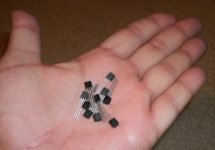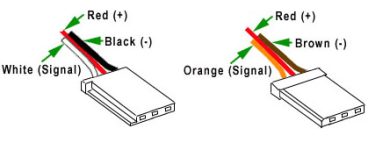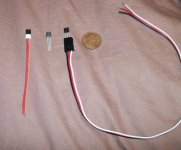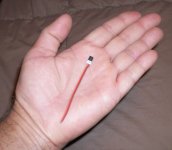spinningmagnets
100 TW
From John in CR: http://endless-sphere.com/forums/viewtopic.php?f=2&t=44529#p648292
From passpato: http://endless-sphere.com/forums/viewtopic.php?f=3&t=39790
_70C = 160F
_93C = 200F
125C = 257F
http://endless-sphere.com/forums/viewtopic.php?f=3&t=53040&p=788864#p790209
From Kepler, drilling a small-diameter hole in the axle and inserting two-wire 10K thermistor to check against internal temps to see if the reaction time was adequate to make this a viable option for temp sensing without dis-assembly of the motor, or running wires through the hollow axle side (which is squeezed due to fat phase wires)
http://endless-sphere.com/forums/viewtopic.php?f=4&t=37964&start=1450#p733858
http://endless-sphere.com/forums/viewtopic.php?f=2&t=53436
Move the thermistor switch to the stator steel near the windings instead of attached directly to the windings. That's where the motor factory installs the thermistor on the high efficiency hubbies I use. They use a 95°C trigger temp, but these motors have a lot more steel and the thermistor is at least 1cm from the windings. That way the short spikes in winding temps don't trigger the switch and it's better tied to the stator temp as a whole.
From passpato: http://endless-sphere.com/forums/viewtopic.php?f=3&t=39790
I have discovered that the max temp for the [Heinzmann] motor is 125 degrees C
_70C = 160F
_93C = 200F
125C = 257F
The LM35 sensors I've looked at range from freezing up to 150C / 302F
http://endless-sphere.com/forums/viewtopic.php?f=3&t=53040&p=788864#p790209
My crystalyte fried when I was cruising around the neighborhood, I wasn't pushing it hard or racing or anything. My motor started intermittently jittering every 10 minutes or so (for a second or two). The temp gauge started to rapidly rise from 80 celcius to 110c. Once the motor hit 115C the motor stopped working and all throttle inputs solely resulted in only motor jittering. The motor smelled of smoke (I had a drilled side cover).
When I got home I opened the motor cover and found that a bearing had ground down the phase wires and shorted two of them together. I soldered on new phase wires added a piece of plastic as a barrier to the wires, put everything back together again and everything was working great for about 30 seconds then went back into jitter mode and smelled of smoke again. I tore the motor down again and found a black char mark on one of the copper wires (windings I think they are called?).
From Kepler, drilling a small-diameter hole in the axle and inserting two-wire 10K thermistor to check against internal temps to see if the reaction time was adequate to make this a viable option for temp sensing without dis-assembly of the motor, or running wires through the hollow axle side (which is squeezed due to fat phase wires)
http://endless-sphere.com/forums/viewtopic.php?f=4&t=37964&start=1450#p733858
http://endless-sphere.com/forums/viewtopic.php?f=2&t=53436
Needed a starting point to set the CA to so I went with temperatures I typically see on the motor casing when measuring with a infrared thermometer. I know from previous experience including motor failures that 55 degC (on the sideplate) is a safe max temperature with anything over 60 degC being dangerous territory. with this in mind, rollback was set to 50 degC and cutout to 60 degC as a starting point.
So off for a ride at one of my local torture tracks to get some data.
First thing I noticed was that the temp at the motor shaft was surprisingly reactive to changes in motor load. Hard hill climbs would see temps rise quickly with coasting down the other side quickly seeing temps drop off again. My expectations were that the heat sink effect of the stator and motor shaft would make temperature reactions very slow but this certainly wasn't the case.
Every few minutes I would stop and measure the motor casing with my infrared thermometer and discovered that the two temperatures tracked quite closely but with a DeltT of around 8K (shaft temperature showing approx 8 degC lower then the motor case).
So with the data collected, l set the CA up for 42 degC rollback and 52 degC cutout (at the center of the axle).










